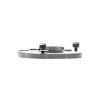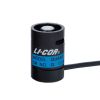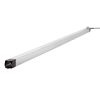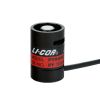LI-COR LI-210R Photometric Sensors
Features
- Provides a spectral response that matches the CIE curve within +/-5% with most light sources
- Sensors are used to measure lighting conditions where the eye is the primary receiver
- Removable sensor simplifies installation and removal of the sensor
- Free ground shipping
- Expedited repair and warranty service
- Lifetime technical support
- More
Overview
The LI-210R Photometric Sensor measures light with the same sensitivity as a typical human eye. The photometric sensor is ideal for evaluating illumination in work areas, exhibits, interior lighting, and in public spaces.
Mechanics
The LI-210R measures light with a precision-filtered silicon photodiode that is sensitive to light centered in the visible spectrum. It responds to light with sensitivity that is close to the human eye, as described by the International Commission on Illumination (CIE) Standard Observer Curve. Cosine corrected to 82° incident angles for accurate measurements when the light source is not directly overhead.
- Absolute Calibration: ± 5% traceable to the U.S. National Institute of Standards and Technology (NIST)
- Sensitivity: Typically 30 μA per 100 klux
- Linearity: Maximum deviation of 1% up to 100 klux
- Response Time: Less than 1 μs (2 m cable terminated into a 604 Ohm load)
- Temperature Dependence: ± 0.15% per °C maximum
- Cosine Correction: Cosine corrected up to 82° angle of incidence
- Azimuth: < ± 1% error over 360° at 45° elevation
- Tilt: No error induced from orientation
- Detector: High stability silicon photovoltaic detector (blue enhanced)
- Sensor Housing: Weatherproof anodized aluminum housing with acrylic diffuser and stainless steel hardware; O-ring seal on the sensor base
- Size: 2.36 cm Diameter × 3.63 cm (0.93” × 1.43”)
- Weight: 24 g head; 60 g base/cable (2 m) with screws
- Cable Length: 2 m, 5 m, 15 m, 50 m (6.5’, 16.4’, 49.2’, 164’)
In The News
With A Modular Update, LI-COR Terrestrial Light Sensors Shine
For environmental professionals looking to measure light, the sun’s energy or photosynthetically active radiation, there is no better choice than LI-COR’s all-new line of terrestrial light sensors. The series, including the LI-190R, LI-200R and LI-210R, has been redesigned from the ground up and is more convenient, reliable and durable than ever before. The new design centers on a modular setup that lets users detach the sensor head from the base. This makes it possible to swap out sensor heads for calibration or to measure different light parameters. In addition, it adds to project flexibility, saving users time and money.
Read MoreFrom Hurricanes to Florida’s Red Tides: Monitoring the Southwest Gulf Coast
Nearly every year, southwest Florida is blighted by harmful Karenia brevis blooms–known colloquially as Florida red tides. These harmful algal blooms (HABs) form over the West Florida shelf and are pushed shorewards by winds and currents. Once in touching distance of the coast, they often intensify, fed by land-based runoff, anthropogenic nutrients, and decomposing marine life killed by toxins produced by these red tides. Red tides have become more severe and persistent over the past 20 years, causing major environmental and economic damage.
Read MoreWave-Powered Buoy Deployed in Puget Sound
While the development of solar-powered monitoring systems has improved access to real-time environmental data, solar power is still limited by low light conditions, such as poor weather, nighttime, or high-latitude environments. To supplement these incumbent power solutions at sea, Ocean Motion Technologies has developed a small-scale ocean wave energy system that can be directly integrated with existing data buoy platforms. Not only does wave energy supplement solar power during periods when the buoys are limited by light availability, but it also allows data buoys to perform beyond their current power capacities.
Read More

































